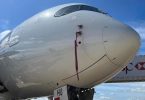The U.S. Department of Transportation’s Bureau of Transportation Statistics (BTS) reported today that U.S. airlines’ systemwide (domestic and international) scheduled service load factor – a measure of the use of airline capacity – fell to 83.3 percent in January, seasonally adjusted, falling for the second consecutive month.
The seasonally-adjusted load factor declined from December (83.5) to January (83.3) because system capacity grew faster (0.6 percent increase in Available Seat-Miles (ASMs)) than the growth in passenger travel (0.3 percent increase in Revenue Passenger-Miles (RPMs)).
Load factor is a measure of the use of aircraft capacity that compares the system use, measured in RPMs as a proportion of system capacity, measured in ASMs.
Without adjusting for seasonal variability, systemwide passenger enplanements (62.5 million) reached an all-time January high, up 2.7 percent from the previous high (60.8 million) reached in 2016.
Trends:
Seasonally-adjusted
Systemwide load factor (83.3) was down 1.3 points from the all-time seasonally-adjusted high (84.6) reached in October 2015. Domestic load factor (84.3) was down 1.4 points from the all-time seasonally-adjusted high (85.7) reached in October 2015. International load factor (80.7) was down 2.5 points from the all-time seasonally-adjusted high (83.3) reached in March 2013.
Systemwide RPMs (79.0 billion) reached a new seasonally-adjusted all-time high, up 0.3 percent from the previous high in December 2016 (78.7 billion). Domestic RPM (56.1 billion) reached a new seasonally-adjusted all-time high, up 0.5 percent from the previous high in November 2016 (55.8 billion). International RPMs (22.9 billion) were down 0.7 percent from the all-time seasonally-adjusted high (23.0 billion) reached in June 2016.
Systemwide ASMs (94.9 billion) reached a new seasonally-adjusted all-time high, up 0.6 percent from the previous high in December 2016 (94.3 billion). Domestic ASMs (66.5 billion) reached a new seasonally-adjusted all-time high, up 0.8 percent from the previous high in December 2016 (66.0 billion). International ASMs (28.3 billion) were down 0.2 percent from the all-time seasonally-adjusted high (28.4 billion) reached in June 2016.
Systemwide passenger enplanements (69.3 million) were down 0.1 percent from the all-time seasonally-adjusted high (69.4 million) reached in November 2016. Domestic passenger enplanements (60.5 million) were down 0.4 percent from the all-time seasonally-adjusted high (60.8 million) reached in November 2016. International passenger enplanements (8.8 million) reached a new seasonally-adjusted all-time high, up 0.7 percent from December 2016 (8.7 million).
Seasonally adjusted trends are for the time period January 2000 to present.
Unadjusted
Systemwide load factor (79.4) was down 0.9 points from the all-time January high (80.3) reached in 2014. Domestic load factor (79.5) was down 1.2 points from the all-time January high (80.7) reached in 2014. International load factor (79.2) was down 0.4 points from the all-time January high (79.6) reached in 2014.
Systemwide RPMs (71.4 billion) reached an all-time January high, up 3.1 percent from the previous high (69.3 billion) reached in 2016. Domestic RPMs (50.1 billion) reached an all-time January high, up 4.2 percent from the previous high (48.1 billion) reached in 2016. International RPMs (21.3 billion) reached an all-time January high, up 0.5 percent from the previous high (21.2 billion) reached in 2016.
Systemwide ASMs (89.9 billion) reached an all-time January high, up 4.1 percent from the previous high (86.3 billion) reached in 2016. Domestic ASMs (63.0 billion) reached an all-time January high, up 3.9 percent from the previous high (60.6 billion) reached in 2008. International ASMs (26.9 billion) reached an all-time January high, up 0.8 percent from the previous high (26.7 billion) reached in 2016.
Systemwide passenger enplanements (62.5 million) reached an all-time January high, up 2.7 percent from the previous high (60.8 million) reached in 2016. Domestic passenger enplanements (54.0 million) reached an all-time January high, up 2.8 percent from the previous high (52.5 million) reached in 2016. International passenger enplanements (8.5 million) reached an all-time January high, up 2.1 percent from the previous high (8.3 million) reached in 2016.
Unadjusted trends are for the time period January 1996 to present.
(eTN): BTS: US airline load factor down to 83.3 percent | re-post license | post content























